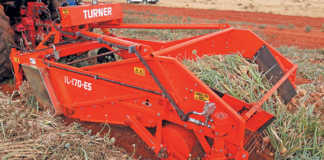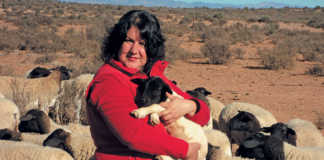
Photo: Glenneis Kriel
Kleiheuwel, situated near L’Agulhas in the Western Cape’s Overberg region, has a rich farming heritage. It was once part of the historic Zoetendals Vallei farm that belonged to the Van Bredas of Bredasdorp, who owned South Africa’s first commercial Merino flock in 1817.
While Merinos are no longer produced on the original farm, Kleiheuwel has continued the Merino tradition, and the flock had steadily improved with each passing generation.
“My father, John Albertyn, and my husband André and I have all put great effort into breeding sheep with good wool qualities, resulting in the flock looking totally different from what it did two generations ago,” says Pam Christie-Smith, who belongs to the sixth generation on the farm.
Good genetics
The Albertyn family started keeping records of the flock in 1942, and travelled across South Africa in search of superior Merino rams to improve it. In time, John Albertyn bought all his rams at production auctions from breeders such as Staatmaker Merinos, Patryskraal Merinos, and Komarsekraal in the Southern Cape.
André Christie-Smith is following suit.
“The genetics of these animals are exceptional, and the sheep are adapted to our production conditions as they are produced around the corner from us,” he says.
“We buy about 20 rams a year and replace them after three years.”
His ram selection strategy is straightforward: “My purchasing decisions are based on BLUP records, specifically wool quality and whether the mother had a history of twins. Because I’m not a stud breeder, I don’t buy the most expensive animals, but usually end up buying animals slightly below the average sales price of the day.”
Wool length is a priority, and he has switched from shearing once a year to every six and eight months as prices are discounted for fleece longer than 90mm.
André’s aim is to produce wool with an average fleece length of 60mm to 70mm, although between 70mm and 80mm would be ideal. The wool diameter averages 18,7 microns for the flock as a whole and 17,5 microns for young ewes.
The wethers are shorn every eight months and the ewes every six months to avoid having to shear all the sheep in the middle of winter or during the lambing or planting season. At the time of writing, the flock comprised about 1 500 ewes, 1 300 lambs and 2 000 wethers.
Better survival
Thanks to tweaks he has made to ewe and lamb management, André has increased the lamb survival rate from 51% to 79% over the past decade. The lambing percentage has increased from 71% to 114% over the same time.
Ewes are scanned and multiples are separated from single pregnancies. Sixty-three percent of the ewes that produce twins or multiples have multiples the year after.
Changing the shearing interval has meant that the ewes are now shorn just before they lamb, ensuring they are in a better condition to look after their young, says André.
Feeding
The feeding regime has also been improved: “Merinos are unlikely to get too fat, with higher consumption generally turning into better wool yields. I’d rather lose a little money by feeding too much than too little. I make that money back in the wool cheque.”
The animals all have access to supplementary feed all year.
André plants 300ha a year in a rotation of wheat with feed crops, such as triticale and oats, as well as barley, of which some is sold to the malting industry. The triticale and barley are usually undersown with lucerne, with the farm having 250ha under lucerne production. The remaining 950ha are under old pastures or veld.
The farm mixes its own feed consisting of maize, triticale and barley or oats, combined with supplements.
Crops, meat and wool account equally for the farm’s income, but the operation is geared towards wool production.
“Wheat is an incidental part of our production system, because it allows us to create sustainable rotations with feed crops, and the sheep can graze the stubble. On the other hand, we regard meat as a by-product of wool production,” says André.
The rams are dosed with 20ml wheat germ once a week for a month to ensure they are in top form by the time they are placed with the ewes, while the ewes receive preformulated supplements from two weeks before the mating season starts in October until six weeks after they have lambed. This helps improve wool quality and milk production and maintain ewe condition.
The lambs are provided with creep feed ad lib after they are born. Consumption usually starts at 10 days after birth.
“John used to say that a lamb doesn’t die of cold if its stomach is full,” says André.
He has bought special feeding troughs with enough space to enable all the sheep in a camp to feed with ease simultaneously. The ewes with lambs are inspected thoroughly and fed in the mornings, and receive a quick check along with feed, often Epol sheep pellets, in the evenings.
“By feeding twice a day, we ensure that the ewes have constant access to fresh food. A ewe that has to go an entire day without food after lambing in the morning won’t be able to look after her lambs.”
Breeding
Pam says that Merinos are notoriously bad mothers, but John addressed this by not raising orphan lambs, and culling ewes that did not look after their lambs.
The same principle is applied today; the ewes have 42 days to take, and all those that don’t conceive are sold. The ewes are mated naturally, with one ram used for every 33 ewes. Young ewes weigh about 90% of their adult weight (65kg on average) when they are placed with the rams.
The wet and dry technique is used to identify ewes failing to rear a lamb. At six weeks of age, the lambs are marked and the udders and teats of the ewes are inspected to determine whether they have milk and are, in effect, rearing lambs. Ewes that do not have milk, or are dry, are culled. Maiden ewes, however, are given a second chance.
Ewes reach their reproductive peak at five years of age, after which they are sold. BKB classes the young ewes at around nine months of age, based primarily on the quality of their wool.
“The ewe shouldn’t have any visible defects and she may be small, but not skinny,” says André. “The BKB agent has years of experience, so he has a much better idea of what makes a great ewe than I have.”
Underrated wethers
Like John before him, André sees the wethers as the money-spinners on the farm, because they produce better wool than the ewes and require fewer inputs. The wethers are castrated at six weeks of age and weaned along with the lamb ewes at about four months of age, depending on veld conditions.
Culled animals are sold to an abattoir in the Eastern Cape.
The wethers receive supplementary feed, such as Condition Lick or Econo Lick, but are kept in larger camps. They are not polled, so can stand their ground against most predators.
André vaccinates the sheep against bluetongue, pulpy kidney, enzootic abortions, tetanus and pasturella, and consults the local veterinary medicine consultants to guide his pest and parasite management programme.
While they sometimes lose a couple of animals to predation, primarily honey badgers, he sees this as part of “nature’s share”.
André regularly attends BKB auctions in Port Elizabeth to strengthen ties with buyers, and the farm has established itself as a fine wool producer, with many wool buyers seeking it out.
“I like the idea of our wool being used in some of the finest suits made in Italy,” says Pam.
Seeing how the industry works has motivated André to take more care in the sorting of wool during shearing to produce more uniform batches. He can now present more lines of wool at auction, garnering much higher returns.
With the sheep being grouped according to their ages and ewes being kept separate from wethers, André has been able to develop full traceability from the wool to a group of animals, without using any special electronics.
“It’s actually quite easy to introduce traceability, as we have such distinct groups and each group is shorn separately,” he says.
He and Pam dream of developing their own wool brand one day, with buyers coming to their farm to buy wool, as is done in Australia.
“We’ve proved that we can produce constant good quality. The problem, however, is that buyers, like everybody else in the country, don’t know what is going to happen in South Africa, making them hesitant to get too closely involved with farms here,” he says.
Email André Christie-Smith at [email protected].










